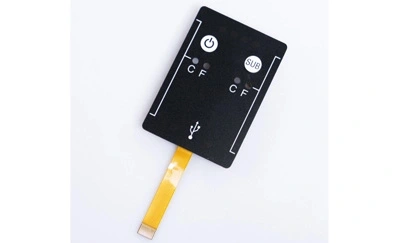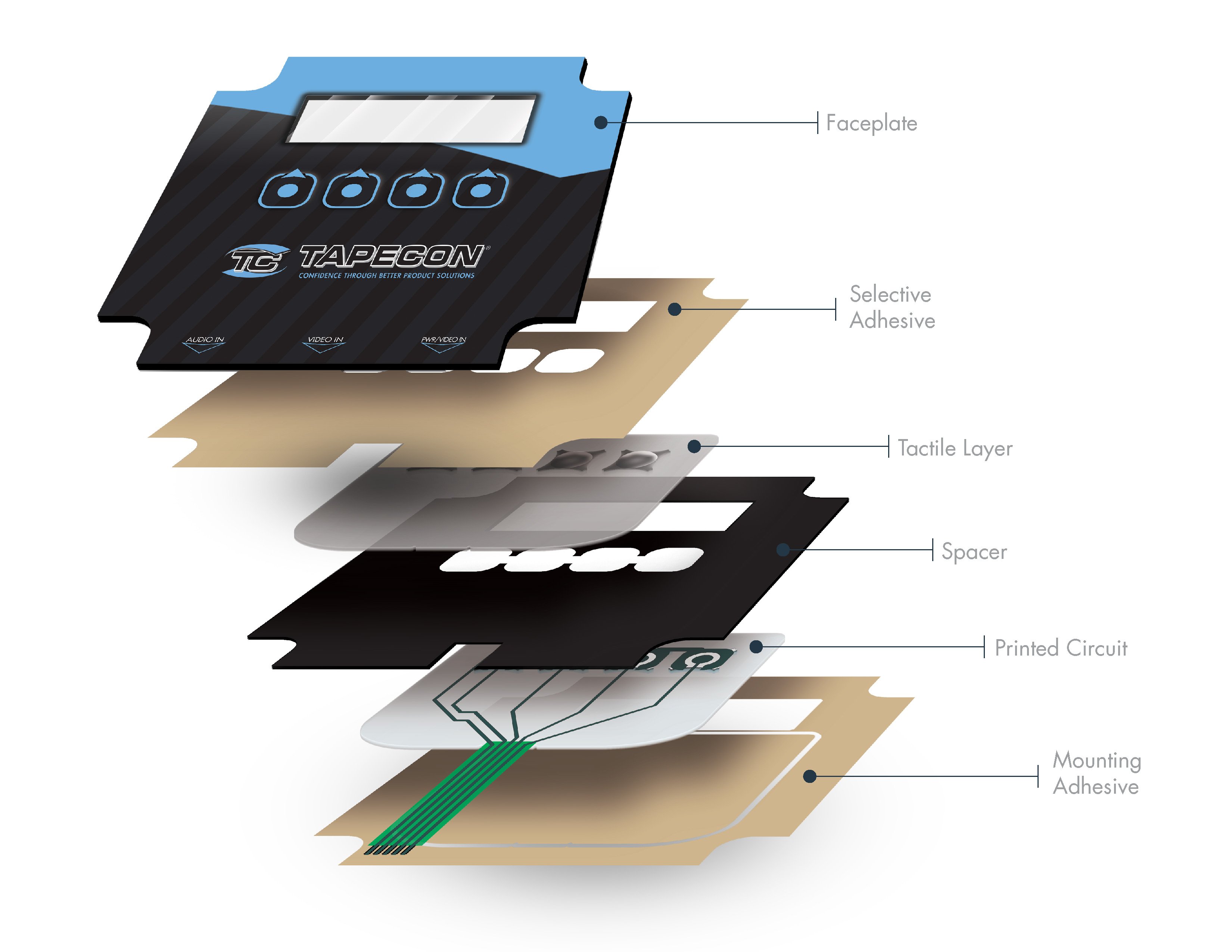Everything About Membrane Switch Over: A Comprehensive Guide for Beginners
Membrane layer buttons are vital components in modern electronics, supplying an one-of-a-kind user interface for individual communication - membrane switch. Their layered construction, consisting of overlays and conductive traces, provides functionality and durability. Unlike standard mechanical switches, membrane buttons provide a streamlined design and personalized options. Comprehending their key functions and advantages can change product style. However, the ins and outs of their application and design considerations call for further exploration
What Is a Membrane Change?
A membrane layer switch is a sort of electrical button that contains a flexible membrane layered over a printed circuit card. This layout permits a sleek and small user interface, typically made use of in various electronic gadgets. Membrane layer buttons are generally found in consumer home appliances, medical devices, and commercial equipment as a result of their resilience and resistance to environmental factors.The building and construction generally consists of several layers, such as visuals overlays and glue support, which supply tactile responses and protect the wiring underneath. The procedure of a membrane switch is launched when stress is used to the surface area, completing an electric circuit.These buttons are valued for their versatility, enabling custom-made layouts and printed graphics that accommodate certain customer interfaces. Their inconspicuous nature minimizes area demands, making them suitable for applications where typical buttons may not fit. In general, membrane buttons supply a useful and aesthetic remedy for modern-day electronic devices.
Trick Parts of Membrane Switches
Membrane layer changes comprise numerous crucial elements that add to their capability and performance. The leading layer, referred to as the overlay, supplies the user interface and is often published with symbols or graphics. Beneath the overlay exists a spacer layer, which separates the conductive components and stops inadvertent activation. The following important component is the graphic layer, which enhances aesthetics and assures the sturdiness of the design.Conductive traces, generally made from products like silver or carbon, are printed on the circuit layer. When stress is put on the overlay, these traces come right into get in touch with, finishing the circuit. Furthermore, a support layer uses architectural assistance and can be made from materials such as polyester or polycarbonate. Together, these components develop a trusted, easy to use user interface suitable for different applications, from household home appliances to commercial equipment. Recognizing these elements is necessary for anyone curious about membrane layer switch innovation.
How Membrane Changes Job
Understanding exactly how membrane layer switches over function is vital for valuing their widespread use in different tools. A membrane layer switch operates with a collection of layers, consisting of a graphic overlay, spacer, and a circuit layer. When pressure is put on the overlay, it compresses the spacer layer, permitting the circuit layer to make contact and complete an electrical circuit. This action sends out a signal to the tool, motivating a reaction, such as activating a light or turning on a function.Membrane switches can be created with numerous features, including responsive responses, backlighting, and personalized graphics, enhancing user interaction. Their building enables a covered layout, shielding the inner components from dirt, dampness, and contaminants. This toughness makes them suitable for diverse applications, from consumer electronic devices to commercial devices. Generally, the simplicity and efficiency of membrane layer switches over add to their appeal in contemporary technology.
Advantages of Membrane Switches Over Mechanical Buttons
While mechanical buttons have long been a staple in numerous devices, membrane switches over deal unique advantages that make them progressively appealing. One significant advantage is their slim account, enabling for more compact layouts and higher flexibility in item growth. Additionally, membrane switches over function an uniform surface area, which improves aesthetic allure and streamlines cleaning, making them ideal for settings where hygiene is critical.Another benefit is their resistance to dirt and moisture. Unlike mechanical buttons, which can be jeopardized by environmental variables, membrane layer switches give a closed interface that shields against impurities - membrane switch. Membrane buttons usually have a longer lifespan due to less relocating parts, resulting in boosted toughness and reliability.Cost-effectiveness is also a remarkable benefit, as membrane layer buttons can be produced in mass with reduced manufacturing expenses. These variables combine to place membrane layer switches as a useful choice to traditional mechanical choices in numerous applications
Common Applications of Membrane Changes
Membrane layer buttons are widely utilized in numerous sectors, especially in consumer electronic devices and commercial control panels. In consumer gadgets, they supply a streamlined, user-friendly interface, while in industrial setups, they improve durability and functionality. Comprehending these applications highlights the convenience and usefulness of membrane switches in modern technology.
Consumer Electronics Tools
As customer electronic devices remain to progress, membrane layer buttons have actually ended up you can look here being a preferred selection for a selection of tools as a result of their versatility and sleek layout. These switches are typically discovered in smartphones, tablet computers, and remote controls, where room is minimal and visual appeals issue. Their low profile and adjustable layouts allow manufacturers to create user-friendly user interfaces that boost the general individual experience. Furthermore, membrane buttons are usually made use of in home appliances such as microwaves and coffee machine, offering intuitive control alternatives while standing up to wetness and dirt. The toughness and integrity of membrane layer changes make them suitable for day-to-day customer products, making certain long life and consistent efficiency. In general, their integration in customer electronics mirrors a blend of functionality and modern-day style.
Industrial Control Panels
The applications of membrane layer changes look here extend past consumer electronic devices, discovering significant usage in industrial control board. These switches are preferred for their sturdiness and resistance to severe environments, making them suitable for producing and procedure control settings. They give a reliable user interface for operators to regulate machinery, display processes, and readjust setups. Membrane layer switches can be tailored to suit certain operational needs, integrating attributes like backlighting and tactile feedback, boosting individual experience. Their low-profile style enables assimilation into numerous equipment, while their capability to hold up against spills, dust, and extreme temperature levels guarantees durability. On the whole, membrane switches contribute to safe and effective procedure in commercial applications, demonstrating their flexibility and performance popular environments.
Considerations for Creating Membrane Layer Switches Over
When designing membrane layer buttons, choosing the appropriate materials is crucial to guarantee toughness and functionality. Additionally, understanding layer setup methods can substantially affect the button's efficiency and customer experience. These considerations play an important role in creating effective and dependable membrane switch designs.
Material Selection Importance
Product option plays an essential role in the design and functionality of membrane layer switches. The selected materials directly affect pop over to these guys the button's durability, responsive feedback, and total aesthetic. Key considerations consist of the substratum, which need to supply structural integrity while enabling adaptability, and the visuals overlay, which needs to be immune to put on and ecological variables. Conductive products ought to guarantee dependable electrical efficiency, while adhesives need to use strong bonding without jeopardizing the switch's operation. In addition, compatibility with producing processes and end-user settings is essential; materials should endure varying temperature levels, moisture degrees, and chemical exposure. Inevitably, proper material option not just improves the membrane layer switch's performance yet also contributes to its durability and individual satisfaction, making it a critical aspect of the design process.

Layer Arrangement Techniques

Often Asked Inquiries
The Length Of Time Do Membrane Layer Switches Typically Last?
Membrane switches generally have a life expectancy of 1 to 5 million cycles, depending on use and environmental problems. Variables such as style quality and operating regularity substantially influence their sturdiness and total performance longevity.

Can Membrane Changes Be Personalized for Certain Styles?
Membrane layer buttons can certainly be tailored to suit particular designs, enabling diverse forms, colors, and functionalities. This versatility makes it possible for producers to customize these buttons to satisfy one-of-a-kind aesthetic and operational requirements effectively.
What Products Are Made Use Of in Membrane Switch Building?
Membrane layer buttons are normally constructed making use of materials such as polyester, polycarbonate, and sticky layers. These materials supply resistance, toughness, and versatility to environmental elements, making sure the switches operate successfully in numerous applications and conditions.
Are Membrane Switches Resistant or waterproof to Moisture?
Membrane switches can be developed to be moisture-resistant, utilizing specialized products and layers. Nonetheless, their water resistant capacities depend upon building and construction quality and particular applications, making it important to evaluate demands for ideal performance in different environments.
Exactly How Are Membrane Switches Repaired if Damaged?
Repairing broken membrane switches typically involves replacing the impacted layer or circuit. Service technicians might likewise use conductive sticky or make use of specialized repair kits, ensuring capability is brought back without total replacement of the whole switch assembly. Unlike traditional mechanical switches, membrane layer switches offer a sleek layout and personalized choices. A membrane layer switch is a kind of electric switch that is composed of a versatile membrane layered over a published circuit board. The operation of a membrane layer button is initiated when stress is applied to the surface, finishing an electrical circuit.These buttons are valued for their convenience, allowing custom-made designs and published graphics that provide to specific individual interfaces. While mechanical switches have long been a staple in many gadgets, membrane switches over offer distinctive advantages that make them significantly appealing. Membrane switches normally have a longer life-span due to less moving parts, resulting in enhanced resilience and reliability.Cost-effectiveness is additionally a remarkable advantage, as membrane buttons can be generated in mass with lower manufacturing expenses.